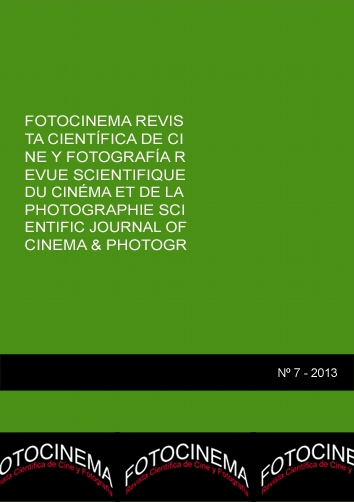El reto tecnológico en la gestión de los procesos productivos cinematográficos; el director de postproducción como eje para la implementación de efectos visuales en España (finales de los 90 - mayo del 2012)
DOI:
https://doi.org/10.24310/Fotocinema.2013.v0i7.5926Abstract
Este trabajo sobre la industria cinematográfica española se enmarca dentro de los estudios dedicados a analizar las consecuencias de la digitalización sobre la configuración de los procesos productivos y las competencias de los profesionales implicados. La postproducción cinematográfica en España es ya digital en la mayoría de los casos, culminando un proceso que se inicia a finales de los 90. Este hecho ha facilitado la digitalización de todos los flujos de trabajo y un proceso de traslación de parte de la creación de la imagen cinematográfica del rodaje a la postproducción. En este contexto estudiamos las implicaciones que se derivan de la normalización de los efectos visuales digitales como herramienta de producción para películas de alto y bajo presupuesto. Así, unido a las necesidades de producción de estos efectos, la volatilidad de la tecnología digital demanda una actualización constante en la dirección de producción del film y nos lleva a evaluar la importancia del director de postproducción como eje para la implementación de las nuevas rutinas productivas.Abstract:
This paper deals with Spanish cinematographic industry and it belongs to the field of studies focused on the workflows digitalization configuration and the changes in the professional competences involved. Cinematographic postproduction in Spain is now digital in most of the cases, completing a process which begins at the end of the 90´s. This fact has contributed to the digitalization of the whole production process and the translation of cinematographic image creation from the shooting to the postproduction. In this framework we approach the implications caused by the normalization of digital visual effects as production tool for high and low budget movies. Therefore, visual effects production needs together with ongoing evolution of digital technology require continuous updating for producers and lead us to assess the relevance of the director of postproduction as a key factor for the implementation of new workflows.
Palabras clave:
Digitalización; Postproducción; Efectos visuales; Director de postproducción.
Keywords:
Digitalization; Post production; Visual effects; Director of post productionDownloads
Metrics
Downloads
Published
How to Cite
Issue
Section
License
All contents published in Fotocinema Revista científica de cine y fotografía are protected under the Creative Commons Attribution-NonCommercial-ShareAlike 4.0 International (CC BY-NC-SA 4.0) license. All about this license is available in the following link: <http://creativecommons.org/licenses/by-nc-sa/4.0>
Users can copy, use, redistribute, share and exhibit publicly as long as:
- The original source and authorship of the material are cited (Journal, Publisher and URL of the work).
- It is not used for comercial purposes.
- The existence of the license and its especifications are mentioned.
There are two sets of authors’ rights: moral and property rights. Moral rights are perpetual prerogatives, unrenounceable, not-transferable, unalienable, imprescriptible and inembargable. According to authors’ rights legislation, Fotocinema. Revista científica de cine y fotografía recognizes and respects authors moral rights, as well as the ownership of property rights, which will be transferred to University of Malaga in open access. The property rights are referred to the benefits that are gained by the use or the dissemination of works. Fotocinema. Revista científica de cine y fotografía is published in an open access form and it is exclusively licenced by any means for doing or authorising distribution, dissemination, reproduction, , adaptation, translation or arrangement of works.
Authors are responsable for obtaining the necessary permission to use copyrighted images.













13.png)




